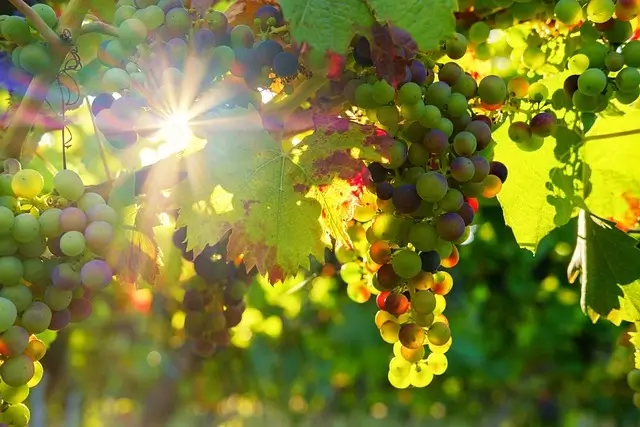Grapes cultivation in India
Grapes cultivation in India is an important horticultural activity, and the country is the second-largest producer of grapes in the world. India produces around 2.8 million tonnes of grapes annually, with Maharashtra and Andhra Pradesh being the two largest producers.
Some related information about grapes is as follows:
Common Name: Grape (in English) and Angoor (in Hindi)
Scientific name: Vitis vinifera
Family: Vitaceae
Viticulture: Viticulture refers to the study and cultivation of grapes that involves all the agricultural practices and studies till the harvest of the grape crop.
Oenology: It is the study and cultivation of grapes for winemaking. Oenology also involves the process of winemaking.
Grapes cultivator states of India
Grapes cultivation in India is a major agricultural industry, primarily concentrated in the states of Maharashtra, Karnataka, Andhra Pradesh, and Tamil Nadu. The country produces a wide variety of grapes, both for table consumption and wine production.
Among these states, Maharashtra is the foremost cultivator state in India. Grape cultivation is very popular in Nasik, Maharashtra. Nasik is called the Wine Capital of India. The state also has its grape packhouse facility.
Grape varieties in India
Seeded varieties –Cardinal, concord Emperor, Italia, Anab-e-shahi, Cheema sahebi, Kalisahebi, Rao Sahebi,
Seedless varieties – Thompson seedless, flame seedless, kishmish chorni, perlette, Arkavati.
Raisin purpose varieties – Thompson seedless, manik chaman, sonaka, Black corinth, Black monukka, Arkavati, Dattier
Wine varieties – Chardonnay, Cabernet Saurignnon, Bangalore Blue, Muscat, Blanc, Pinot Noir, Pinot Blane, White Riesling, and Merlot.
Required conditions for Cultivating Grapes
Grapes are a temperate crop and require mild winters and hot summers with plenty of sunshine. The ideal soil requirement for successful grape cultivation is well-drained loam or clay soil with a pH range of 6.5 to 8.0.
Grape cultivation is generally not done during monsoon. The best planting time for grapes in India is Between February and March for north India and November to January for peninsular India. And between December to January for Karnataka and Tamil Nadu.
The grape plants are planted in a vineyard with a north-south orientation for better sunlight exposure. The vines are pruned and trained for better yield. The main cultural practices for grape cultivation are pruning, training, fertilization, irrigation, and pest and disease management.
The crop of Pomegranate also needs similar conditions like grapes. It is also an important crop of India. Read another article for some amazing tips for Harvesting Organic Pomegranates
Grapes Sowing Process:
Soil preparation
The soil for sowing grapes must be well-drained, loamy, and rich in essential minerals and nutrients. Before sowing it is essential to ensure that the pH factor is maintained within 6.5 to 7. Grapevines are generally planted in pits. The pits are well prepared, maintaining the proper spacing. The depth of the pits ranges from 60 to 90 cm. It is recommended to use any growth mobilizer with complete knowledge because improper use can lead to soil erosion.
Training
Training is an essential step for cultivating grapes. It is done to support the crop for steady and desired growth. Some popular training systems in Indian grape vineyards are the Bower system, Kniffing system, Telephone system, and Head system. The Bower system is the most popular system used in India by cultivators.
Pruning
Pruning is done when the grapevines are dormant. It is done in different lots in different regions. In subtropical region pruning and harvesting is done once only in December. In hot tropical regions, grapevines are pruned two times a year while harvesting is done once. And in mild-topical regions, both pruning and harvesting are done twice.
Irrigation
Irrigation practices also differ in various regions. It differs according to the pruning time, monsoon pattern, type of soil, variety, and training system. In the initial stages of the newly planted crops in the vineyard, irrigation is done once every 3 days.
Fertilizers
The fertilizer schedule also varies according to the time. According to the soil of the vineyards organic manure is good to use as a growth regulator.
Weed Management
Weed uprooting is mostly done through tractor-drawn weeding tools. It is done throughout the year by different implements to keep the rows clean from weeds. Weed management is an important step in cultivation of any crop. Missing this step-in farming can destroy the whole crop.
Disease Management
It is also an important step in cultivating any crop. Dimethoate, Dichlorovas, and Endosulfan are some pest controls that are spread for disease management in vineyards.
Harvesting
One million tonnes of grapes are harvested every year all over India. The ideal time for harvesting is early in the day when the temperature is below 20 degrees. Harvesting time also differs according to the varieties of Grapes.
Storage
Generally, grape life is of one week when stored at room temperature. This shelf life can be extended by deploying certain methods.
Conclusion
The Indian government provides support for the grape industry through schemes for increasing productivity, export promotion, and market development. The industry faces challenges such as limited access to modern technology and lack of proper infrastructure, but the demand for grapes both domestically and internationally is increasing, leading to growth in the industry.

